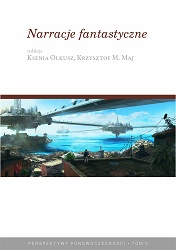Wampir nie potrafi żyć na odludziu
A Vampire Cannot Live in the Outskirts
An Image of a City in "The Vampire Chronicles" by Anne Rice
Author(s): Barbara Szymczak-Maciejczyk
Subject(s): Language and Literature Studies, Philology, Theory of Literature
Published by: Ośrodek Badawczy Facta Ficta
Keywords: New Orleans;Anne Rice;gothic fiction;weird fiction;vampire;vampire novel;
Summary/Abstract: The chapter by Barbara Szymczak-Maciejczyk delivers an analysis of the creation of eighteenth-century Paris and nineteenth-century New Orleans as cities that become lairs for covens of vampires. The American writer describes, in a very picturesque manner, the atmosphere and the operations of erstwhile cities while embedding monsters of an undead nature. The text addresses several issues. There is the labyrinth of the Gothic space; Rice writes of gothic features that include secret passages, abandonedcemeteries, secret rooms, dead-end towers and catacombs which are homes to the Parisian vampires. The author of the paper uses the term “labyrinth” which was coined by Agnieszka Izdebska. The article explores the solitude of an individual in a metropolis. It expounds on the culmination of that solitude with the transformation of a mortal man into the immortal vampire (e.g. kidnapping Lestat, Louis being in dangerous places, leaving Claudia by her dead mother). It also tackles the issue of mirror imagery between the mental state of the characters and the condition of the city and their location at any given moment. The author also points out that the vampires’ desire is not merely driven by hunger and bloodlust but also by a desire for the accumulation of wealth including freely participating in the exchange of money for goods and services. The paper highlights the differences in the understanding of economic issues from the perspectives of a citizen of the Old Continent and the New World. Furthermore, it aims to identify Rice’s methods of creating space with a confined and dangerous element. These literary aesthetics include crossing of barriers to a home’s threshold and a temple and multiple labyrinthine structures. Other vivid imagery includes urban landscapes, e.g., side-streets, stone walls, crumbling stairways—all used as the living, breathing sarcophagus and feeding grounds for undead creatures that hunger and thirst for human blood. The combination of these elements reveals creative and novel methods in Gothic writing and it provides a more modern adaptation for the character of the vampire.
Book: Narracje fantastyczne
- Page Range: 385-402
- Page Count: 18
- Publication Year: 2017
- Language: Polish
- Content File-PDF

